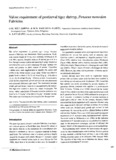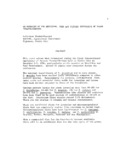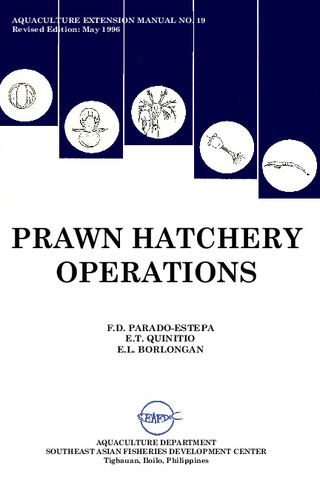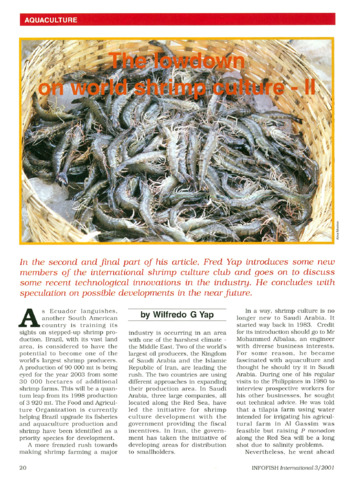Valine requirement of postlarval tiger shrimp, Penaeus monodon Fabricius
Share
Abstract
The valine requirement of juvenile tiger shrimp, Penaeus monodon Fabricius, was determined. Shrimp postlarvae, PL20, with a mean weight of 14 mg, were randomly distributed in 36 oval 40-L capacity fibreglass tanks at 10 shrimp per tank in a flow-through seawater system and reared for 8 weeks. Postlarvae were fed amino acid test diets containing 400 g kg−1 protein with casein and gelatine as intact sources of protein. Crystalline L-amino acids were supplemented to simulate the amino acid profile of the shrimp muscle except valine. Valine was added in graded levels to obtain 7, 10, 13, 16, 19 and 22 g kg−1 of the diet or 18, 25, 33, 40, 48 and 55 g kg−1 of dietary protein. At termination of the feeding experiment, growth and survival were determined and nutritional deficiency signs noted. The relationship between weight gain and dietary valine level was analysed by the broken-line regression method to derive the valine requirement. The dietary valine requirement of Penaeus monodon postlarvae was found to be 13.5 g kg−1 of the diet or 34 g kg−1 of dietary protein. This value was lower than the level found in the shrimp tissue.
Suggested Citation
Millamena, O. M., Bautista-Teruel, M. N., & Kanazawa, A. (1996). Valine requirement of postlarval tiger shrimp, Penaeus monodon Fabricius. Aquaculture Nutrition , 2(3), 129-132. https://doi.org/10.1111/j.1365-2095.1996.tb00051.x
Taxonomic term
Collections
- AQD Journal Articles [1249]
Related items
Showing items related by title, author, creator and subject.
-
An overview of the nutrition, feed and feeding techniques of prawn penaeid/shrimps
Piedad-Pascual, Felicitas (Philippine Council for Aquatic and Marine Research and Development, 1989)This paper echoes what transpired during the first International Conference of Penaeid Prawns/Shrimps held in Iloilo City in December 4-7, 1984, particularly on the Nutrition nd Feed Development. Around 25 papers were ... -
Prawn hatchery operations
Parado-Estepa, Fe D.; Quinitio, Emilia T.; Borlongan, Emeterio L. (Aquaculture Department, Southeast Asian Fisheries Development Center, 1996-05)The manual, an updated version of the 1984 SEAFDEC/AQD manual, presents the underlying principles and step-by-step instructions of prawn larval and post-larval rearing. The techniques described are not only applicable to ... -
The lowdown on world shrimp culture - II
Yap, Wilfredo G. (INFOFISH, 2001)This paper introduces some new members of the international shrimp culture club and goes on to discuss some recent technological innovations in the industry, particularly the polyculture of tilapia (mainly Oreochromis ...




